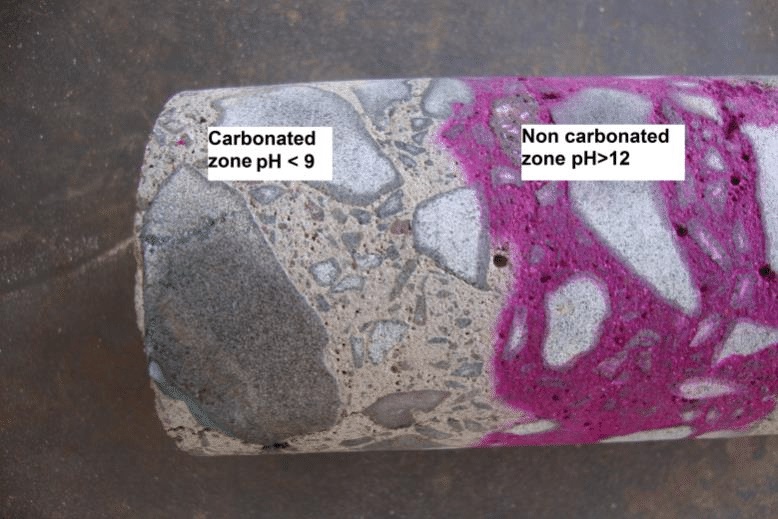CARBONATION

Objective
Carbonation of concrete is a process by which Carbon di Oxide from the air penetrates into the concrete and reacts with calcium hydro-oxide to form calcium carbonates. Conversion of Ca (OH) 2 into CaCO3 by action of CO2 by itself is not reactive. In the presence of moisture, CO2 changes into dilute carbonic acid which attacks the reinforcement and also reduces alkalinity of concrete. In this test Phenolphthalein solution is used as indicator.
Factors Influencing the Rate of Carbonation of Concrete
a) Amount of CO2 in air;
b) Relative humidity of concrete;
c) Amount of precipitation of CaCO3; and
d) Concrete carbonation resistance (concrete permeability and amount of Ca (OH) 2 in concrete)
Procedure
Preparation of Indicator Solution
The indicator solution shall be 1 percent phenolphthalein solution in ethanol. This is prepared by dissolving 1 g of phenolphthalein powder in a 100 ml solution of 70 ml ethanol and 30 ml of de-ionized water OR readily available equivalent phenolphthalein solution.
Preparation of Sample
The test shall be performed on freshly exposed concrete surface. This may be either freshly broken surface of concrete, drilling holes or extracted concrete core sample which may preferably be split and the test may be conducted on the split face. If facility for splitting is not available, then the core may be surface dried and sealed to prevent further carbonation. After breaking, the concrete surface shall immediately be cleared of any dust or loose particles.
Test Procedure
The freshly exposed concrete surface prepared shall be sprayed with a fine mist of indicator solution. Care shall be taken to avoid the formation of flow channels on the test surface.
The measurements shall be conducted soon after the color has stabilized. The demarcation between the
region, which turns into magenta (dark pink color) and the region showing no change in color will indicate
the carbonation front. The carbonation depth shall be measured on the exposed face.
Procedure
The depth of carbonation for exposed face of a specimen shall be calculated and recorded. A minimum of three specimens shall be taken from each structural member. The mean depth of carbonation for each
structural member shall be calculated and recorded
Our Other Services
- Rebound Hammer
- Ultrasonic Pulse Velocity
- Half Cell Potentials
- Concrete Core
- Carbonation
- Cover Meter Survey
- Pile Integrity Test
- Pile Dynamic Test
- Bridge Load Test
- Slab Load Test
- Cross Hole Sonic Test
- In-Situ Metallography (Replica)
- Portable Hardness Test (Rebound & UCI Method)
- Expert Metallurgy Consultant For Site
- Pressure Vessel Inspection & Maintenance
- Condition Assessment
- Remaining Life Assessment
- Fitness For Service
- Pipeline Inspection & Maintenance
- Tank Inspection & Maintenance
- IBR/Non IBR Fabrication
- Structural Health Assessment / Structure Audit
- Reactor Inspection As Per Factory Act





